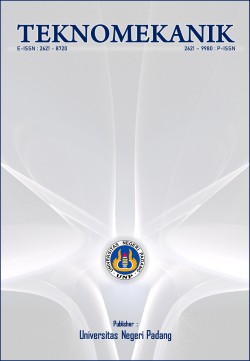Preliminary study of solid waste treatment of Padang Beach tourism area
DOI:
https://doi.org/10.24036/jptk.v4i1.16323Keywords:
Solid waste, Generation, Composition, Recycle potential, Padang BeachAbstract
A preliminary study of the solid waste treatment in the Padang Beach tourist area was done in order to analyze solid waste generation, composition, and the potency of recycling, and to recommend the appropriate treatment system applied to the tourist area. The study revealed that daily waste generated 18.648 L, the components of the waste dominated by food waste 84.215%, plastic 9.254%, paper 2.087%, and non-metal ferrous 1.945%. The potency of recycling of the waste was food waste 91.732%, plastic 88.074%, metals 78.947% and glass 75.758%. This study it is recommends that waste that has an economic value such as plastic, paper, and metal should be collected and sold to a third party, biodegradable waste such as food waste and yard waste should be composted, while other waste that has potency to produce handy craft such as seashell, coconut shell, and sachet packaging should be collected and processed, all treatment activities can be done at the recycling centre that located in the tourist area.
Downloads
References
Dinas Pariwisata Kota Padang, 2017. Laporan Tahunan Kepariwisataan Kota Padang.
Surat Keputusan Walikota Padang No. 550 Tahun 2014 tentang Kawasan Bebas Sampah.
Peraturan Daerah Kota Padang No. 3 Tahun 2014 tentang Rencana Induk Pembanguan Pariwisata Kota Padang
Undang Undang Republik Indonesia No. 18 Tahun 2008 tentang Pengelolaan Sampah
Peraturan Pemerintah RI No. 81 Tahun 2012 tentang Pengelolaan Sampah Rumah Tangga dan Sampah Sejenis Sampah Rumah Tangga
Damanhuri E and Padmi T, Pengelolaan Sampah Terpadu, Penerbit ITB: Bandung, 2016
Bhat RA, Nazir R, Ashraf S, Ali M., Bandh SA, and Kamili AN 2014 Waste Manage Res. 32 165– 169.
Zorpas AA, Irene Voukkali I, and Loizia P 2015 Desalin Water Treat. 56 1141-1149.
Arbulú I, Lozano J, Rey-Maquieira J 2016 Waste Manage. 51 252-258.
Hoang MG, Fujiwara T, and Pham Phu ST 2017 Journal of JSCE. 5 123-132
Giurea R, Precazzini I, Ragazzi M, Achim MI, Cioca LJ, Conti F, Torretta V, and Rada EC 2018 Resources. 7 1-12
Naltaru M, Purmaini R, dan Irsan R 2014 Perencanaan Sistem Pengelolaan Sampah di Kawasan Wisata Bukit Kelam Kabupaten Sintang. Undergraduate Thesis. Universitas Tanjungpura: Pontianak
Wijaya IW, dan Trihadiningrum Y 2014 Strategi Penanganan Sampah di Objek Wisata Eks Pelabuhan Buleleng, Bali. Undergraduate Thesis. Institut Teknologi Sepuluh Nopember: Surabaya
Akbari R, Analisis Timbulan dan Komposisi Sampah di Kawasan Bhumi Merapi dan Stonehenge Kaliurang, Sleman, D.I. Yogyakarta. Tugas Akhir. Jurusan Teknik Lingkungan, Universitas Islam Indonesia. 2018
Oktiasari R, Evaluasi Pengelolaan Sampah Wisata Gunungpring Kecamatan Muntilan Kabupaten Magelang Jawa Tengah Dengan Metode Zero Waste Index . Tugas Akhir. Jurusan Teknik Lingkungan, Universitas Islam Indonesia. 2018
R Aziz and Mira 2019 IOP Conf. Ser.: Mater. Sci. Eng. 602 012059
Jefri dan Aziz. 2018. Studi Potensi Daur Ulang Sampah Kawasan Wisata Taman Marga Satwa dan Budaya Kinantan (TMSBK) dan Kawasan Wisata Taman Panorama dan Lobang Jepang (TPLJ) di Kota Bukittinggi. 5th ACE Conference. Padang
Aziz and Jefri, 2019, Improvement of Solid Waste Management System of Tourism Area in Bukittinggi City in Supporting The Implementation of Sustainable Tourism. Proceeding of Tourism Development Center International Conference, October 2019, Bukittinggi,
Downloads
Published
Issue
Section
License
Copyright (c) 2021 Rizki Aziz, Gloria Poppy Adfuza, Yaumal Arbi

This work is licensed under a Creative Commons Attribution 4.0 International License.





